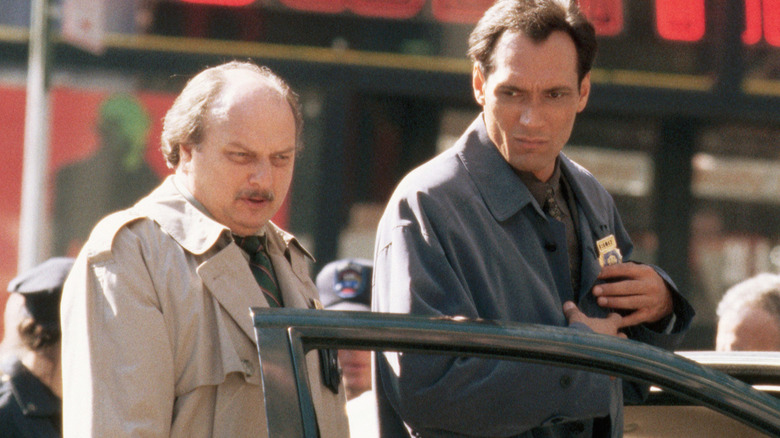NYPD Blue: How An ABC Cop Show Changed TV Nudity Forever
Steven Bochco's "NYPD Blue" changed the game when it premiered in 1993. The ABC series wasn't afraid to show the kind of nudity that, up to that point, had been unthinkable on network TV, all while crafting a legacy as one of the best crime shows of all time. However, the show's approach to nudity received considerable pushback from the Federal Communications Commission when the Season 10 episode "Nude Awakening" showed Charlotte Ross' character, Connie McDowell, accidentally encountering a young boy in a bathroom while naked.
Though brief, non-sexual, and carefully framed to avoid full frontal nudity, the scene was enough for the FCC to leap at "NYPD Blue." The scene shows Ross from behind, and since such content needed to run after 10 P.M. and "NYPD Blue" ran before that in some areas, the commission slapped ABC with a fine that amounted to $1.4 million. ABC didn't take this lying down, and the case was struck down by the US Court of Appeals in 2011. Together with Fox's battle with the FCC over prime-time swearing, The "NYPD Blue" situation made its way to the Supreme Court in 2012. Again, the FCC ended up on the losing end.
While "NYPD Blue's" nudity policy and success in defending it in the courtroom put it in a pretty clear groundbreaker position, Bochco himself has lamented how little use network television ultimately made of it. "It's one of the enduring surprises to me that it pretty much stopped there for network TV," he told GQ in 2014. "Once we were a hit, I thought it would really open a door." However, he did note that cable continued to carry the prestige show nudity torch, and since streaming networks followed suit later, it seems pretty clear that "NYPD Blue" was a trailblazer.
The show had a surprise ally in Bob Iger
Fascinatingly enough, Bob Iger was at the forefront of "NYPD Blue's" charge to change the on-screen nudity game. Before his Disney CEO days, Iger headed ABC, and as Bochco told GQ, the executive was extremely involved with the police procedural's approach to showing skin. "So we sat in [Iger's] office like two little boys, drawing dirty pictures: naked men and women," Bochco said. "'How much of this can you see? How much of that?'" This unconventional but careful preparation allowed "NYPD Blue" to push the envelope as much as possible.
Iger didn't just stand by Bochco's vision but actually put his career on the line while doing so. Per CNN, CEO Dan Burke of ABC's parent company, Capital Cities, had a word of warning to Iger when the ABC head championed "NYPD Blue" to him. "You'd better be right," Burke said. "Because if you're wrong, my skirts won't be big enough for you to hide behind."
Apart from Bochco and Iger's focus on the nudity aspect, the show's willingness to push the envelope allowed co-creator David Milch to focus on edgier content than other shows of the era. Apart from depicting grittier cases and more morally grey methods than viewers were used to, this also allowed "NYPD Blue" to usher in the era of deeply flawed protagonists á la Walter White (Bryan Cranston) or Don Draper (Jon Hamm), in the shape of the show's overarching central character, Andy Sipowicz (Dennis Franz).

